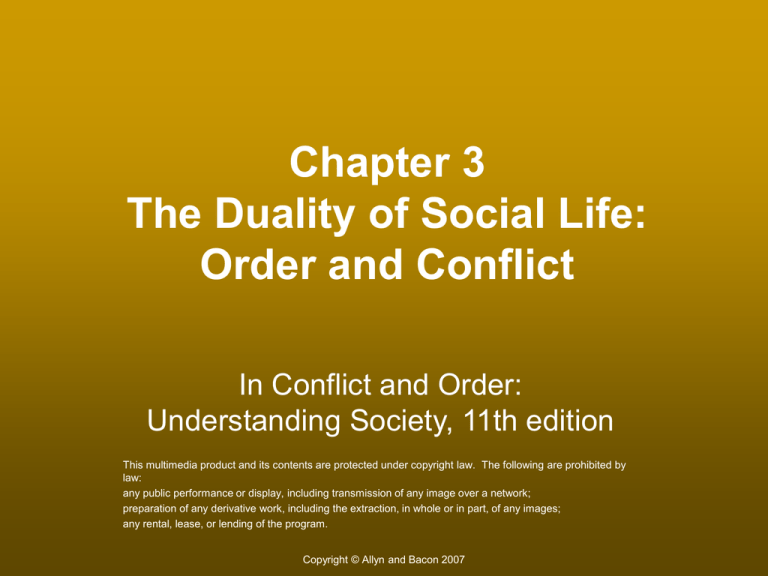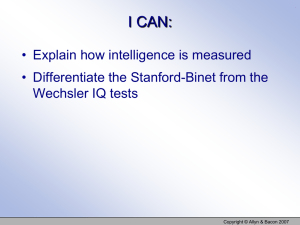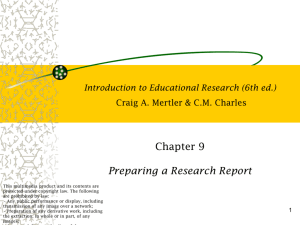Chapter 3 The Duality of Social Life: Order and Conflict
advertisement

Chapter 3 The Duality of Social Life: Order and Conflict In Conflict and Order: Understanding Society, 11th edition This multimedia product and its contents are protected under copyright law. The following are prohibited by law: any public performance or display, including transmission of any image over a network; preparation of any derivative work, including the extraction, in whole or in part, of any images; any rental, lease, or lending of the program. Copyright © Allyn and Bacon 2007 Social Systems: Order and Conflict • Sociologists have a mental image (model) of how society is structured, how it changes and what holds it together. • The two prevailing models of order and conflict provide contradictory images of society. Copyright © Allyn and Bacon 2007 Social Systems: Order and Conflict • The Order Model – Is sometimes called Functionalism – Attributes to societies the attributes of cohesion, cooperation, reciprocity, stability and persistence – Manifest consequences—intended – Latent consequences—unintended Copyright © Allyn and Bacon 2007 Social Systems: Order and Conflict • The Conflict Model – The view of society that posits conflict as a normal feature of social life, influencing the distribution of power and the direction and magnitude of social change Copyright © Allyn and Bacon 2007 Copyright © Allyn and Bacon 2007 The Duality of Social Life • Sport from the Order Perspective – Preserves the existing social order by symbolizing the American way of life – Supports the status quo by promoting the unity of society’s members through patriotism – Socializes youths into proper channels Copyright © Allyn and Bacon 2007 The Duality of Social Life • Sport from the Conflict Perspective – Sport is organized to exploit athletes and meet the goals of the powerful – Sport inhibits the potential for revolution by society’s have-nots. Copyright © Allyn and Bacon 2007 Social Problems from the Order and Conflict Perspectives • Social Problems are societally induced conditions that harm any segment of the population or acts or conditions that violate the norm and values of society Copyright © Allyn and Bacon 2007 Synthesis of the Order and Conflict Models • Assumptions of a synthesis approach: – The processes of stability and change are properties of all societies. – Societies are organized, but the process of organization generates conflict. – Society is a social system. Copyright © Allyn and Bacon 2007 Synthesis of the Order and Conflict Models (continued) – Societies are held together by complementary interests, by consensus on cultural values, and also by coercion. – Social change is a ubiquitous phenomenon in all societies. It may be gradual or abrupt, reforming or revolutionary. Copyright © Allyn and Bacon 2007 Division and Violence • The divisive forces bringing about segmentation in U.S. society – Size – Social Class – Race – Ethnicity – Sexual Orientation – Religion Copyright © Allyn and Bacon 2007 Violence and the Myth of Peaceful Progress • The myth of peaceful progress – The incorrect belief that through throughout U.S. history disadvantaged groups have gained their share of power, prosperity, and respectability without violence Copyright © Allyn and Bacon 2007 Violence and the Myth of Peaceful Progress • • • • • • • Revolutionary colonists Native Americans Exploited Farmers Slaveholders WASP Supremacists Ethnic Minorities Labor Disputants Copyright © Allyn and Bacon 2007 The Integrative Forces in Society • • • • Functional Integration Consensus on Societal Values The Social Order Group Membership Copyright © Allyn and Bacon 2007 The Integrative Forces in Society • • • • International Competition and Conflict The Mass Media Planned Integration False Consciousness Copyright © Allyn and Bacon 2007





